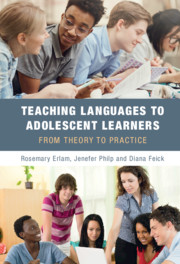In our work, we are often inspired by the ways in which language teachers put second language acquisition theory into practice in their classrooms. So we decided to write a book that would showcase the brilliant work of modern language teachers across a range of instructional contexts. We chose instructional contexts that have two important features in common: they are high/secondary schools and the learners are adolescents. This is because a second main aim of this book is to highlight the needs of the adolescent language learner. We believe that adolescence is a prime time for language learning.
The book is written specifically for those involved in or interested in the teaching and learning of modern languages (also referred to as foreign languages), whether teachers, teacher-trainers, or students. In each chapter, we highlight theory relating to a specific aspect or aspects of language teaching and learning, drawing from both education and applied linguistics. We illustrate how this theory translates into good classroom practice using examples from naturalistic classroom contexts and from teachers who are very experienced. These examples are drawn from classroom observation and recordings, as well as teacher and student interviews. The students, from Years 7 to 13, ages 12 to 18, are all in high school and studying languages such as English, French, Spanish, Chinese, German, and Japanese, taught in a variety of contexts. We draw attention to how the instruction we observed is particularly suited to the needs of the adolescent language learner. We hope that you enjoy the stories of the teachers and students in this book and seeing excellent examples of theory in practice. We hope that these will inspire you as they have us, and that they will encourage you to reflect and perhaps even try out new ideas, whether you are a language teacher or learner!

